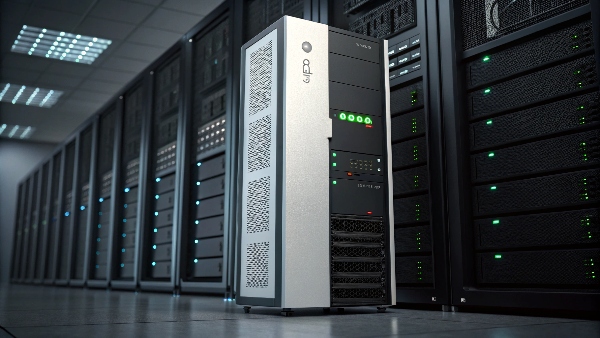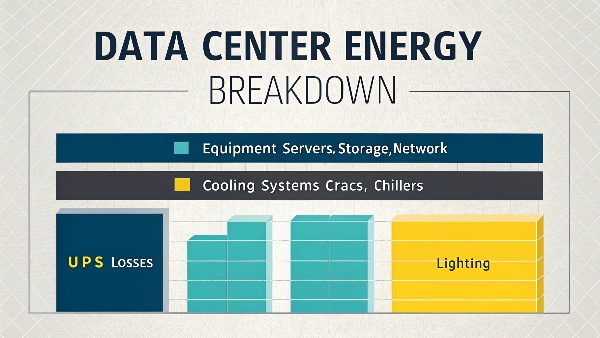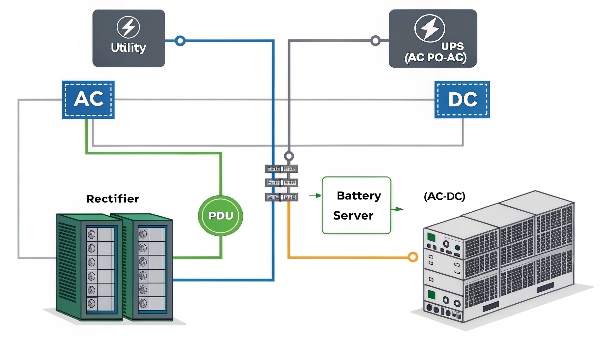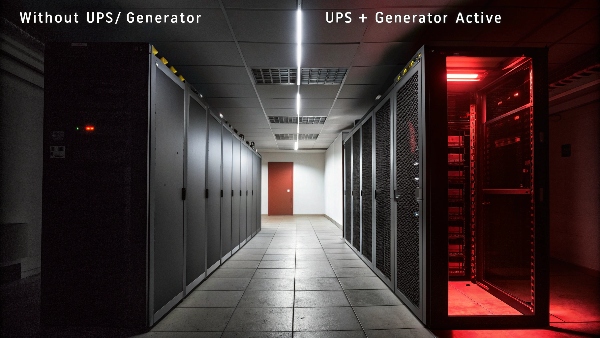Data centers are the digital hearts of modern business, constantly pumping information. What makes their power supply so uniquely vital, and what are the real risks of even a momentary lapse?
Uninterrupted power is non-negotiable for data centers. It prevents catastrophic data loss, service outages, and equipment damage, ensuring continuous operation for critical digital services reliant on constant availability.
Data centers absolutely must use uninterruptible power supplies (UPS). We can provide corresponding solutions based on customer needs, such as lithium battery UPS or lead-acid battery UPS systems.

Transition Paragraph:
At Daopulse, with our decade of experience manufacturing UPS systems, we've seen firsthand the critical reliance data centers have on continuous power. My core insight is that data centers absolutely must use uninterruptible power supplies. We can provide corresponding solutions based on customer needs, such as lithium battery UPS or lead-acid battery UPS systems. For clients like Mr. Li, a Procurement Manager ensuring hospital infrastructure uptime, this isn't a luxury; it's a fundamental requirement for operational integrity and patient safety. The consequences of power failure are simply too severe to ignore.
Why do data centers require so much power?
The energy consumption of data centers is often highlighted. What is it about these facilities that drives such an enormous and constant demand for electricity?
Data centers require immense power to run thousands of servers, storage devices, and networking equipment 24/7, plus the extensive cooling systems needed to prevent these components from overheating.

The sheer scale and intensity of operations within a data center are the primary reasons for their high power consumption. As manufacturers of UPS systems that support these power-hungry environments at Daopulse, we see this demand daily. My understanding, reinforced by my insight that data centers absolutely must use uninterruptible power supplies, is tied to the non-stop nature of their load.
Here’s a breakdown of the key power consumers:
- IT Equipment (Servers, Storage, Networking): This is the core load. Thousands, sometimes tens of thousands, of servers are constantly processing data, running applications, and serving user requests. Storage arrays (SANs, NAS) consume power storing and retrieving vast amounts of information. Networking gear (switches, routers, firewalls) manages the data flow. All these devices run 24/7.
- Cooling Systems (HVAC): All that IT equipment generates a tremendous amount of heat. To prevent overheating and ensure optimal performance and longevity of the components, data centers employ sophisticated and powerful cooling systems. These include Computer Room Air Conditioners (CRACs), Computer Room Air Handlers (CRAHs), chillers, and pumps, which are themselves significant power consumers. Often, for every watt consumed by IT, nearly as much can be consumed by cooling, though PUE (Power Usage Effectiveness) improvements are constantly sought.
- Power Infrastructure Losses: The UPS systems themselves, power distribution units (PDUs), transformers, and cabling all have some inherent electrical losses (efficiency is never 100%). While we strive for high efficiency in our UPS designs, some energy is inevitably converted to heat.
- Lighting and Ancillary Systems: Though a smaller portion, lighting, security systems, and monitoring equipment also contribute to the overall power draw.
The relentless "always-on" nature of modern digital services means data centers cannot simply power down components to save energy; they must be ready to serve requests at any moment.
What does a PDU do in a data center?
Power needs to get from the UPS to individual servers and devices. What role does a Power Distribution Unit (PDU) play in this critical path?
A PDU in a data center distributes the conditioned power from the UPS to multiple devices within server racks, often providing features like individual outlet control, power monitoring, and remote management.

Power Distribution Units (PDUs) are essential components in the data center power chain, acting as sophisticated power strips designed for the demanding environment of IT racks. At Daopulse, while our main focus is UPS systems, we understand how PDUs integrate with our products to deliver reliable power to the load. The necessity of uninterruptible power, as per my insight that data centers absolutely must use uninterruptible power supplies, extends to how that power is reliably distributed.
Here's what PDUs do:
- Power Distribution1: Their primary function is to take a single, higher-current power input (often from the UPS output) and distribute it to multiple lower-current outlets, providing power to individual servers, storage units, and network switches within a rack.
- Outlet Density: They provide a high number of outlets in a compact form factor, suitable for densely packed server racks. They come in various forms, such as basic, metered, switched, and intelligent/managed PDUs.
- Power Monitoring (Metered/Managed PDUs)2: More advanced PDUs can monitor power consumption at the PDU level or even at individual outlets. This data is crucial for capacity planning, identifying overloaded circuits, and energy efficiency initiatives.
- Remote Outlet Control (Switched/Managed PDUs)3: These allow administrators to remotely turn individual outlets on or off. This is invaluable for rebooting unresponsive servers without needing physical access to the rack, saving time and operational costs.
- Environmental Monitoring (Intelligent PDUs): Some high-end PDUs can integrate with environmental sensors to monitor temperature and humidity within the rack, providing early warnings of potential issues.
- Overload Protection: PDUs typically have circuit breakers to protect against overloads, preventing damage to connected equipment and the PDU itself.
Essentially, PDUs ensure that the clean, reliable power from the UPS is safely and intelligently delivered to each piece of IT equipment. They enhance manageability, provide crucial data, and contribute to the overall reliability of the data center.
| PDU Type | Key Features | Primary Benefit |
|---|---|---|
| Basic | Simple power distribution | Cost-effective, reliable power delivery |
| Metered | Displays power consumption (PDU or circuit level) | Helps in load balancing, capacity planning |
| Switched | Allows remote on/off control of individual outlets | Enables remote reboot of equipment, power cycling |
| Managed/Intelligent | All above + network interface, environmental monitoring | Full remote control, detailed analytics, proactive alerts |
Why do data centers use DC power?
We often hear about AC power from the utility. Why is DC (Direct Current) power gaining traction or used in specific parts of data centers?
Some data centers use DC power distribution to improve energy efficiency by reducing AC-to-DC conversions. IT equipment internally uses DC, so direct DC supply minimizes conversion losses, simplifying power paths.

While traditional data centers predominantly use AC (Alternating Current) power distribution, there's a growing interest and adoption of DC power, particularly 48V DC or ~380V DC systems. My insight that data centers absolutely must use uninterruptible power supplies, and we can provide solutions like lithium or lead-acid battery UPS, also means we stay attuned to evolving power architectures.
Here's why DC power is considered:
- Improved Energy Efficiency: Most IT equipment (servers, storage) internally operates on DC voltages (e.g., 12V, 5V, 3.3V). In a typical AC setup, power goes through multiple conversions:
- Utility AC to UPS DC (rectifier).
- UPS DC back to clean AC (inverter).
- Server Power Supply Unit (PSU) converts AC back to various DC voltages.
Each conversion step incurs energy losses (typically 5-20%). A DC power architecture aims to reduce these conversions. For example, a 380V DC system might involve rectifying utility AC to 380V DC, which then directly feeds server PSUs designed for 380V DC input, eliminating the UPS inverter stage and one AC-DC conversion in the server PSU.
- Reduced Complexity and Points of Failure: Fewer conversion stages can mean a simpler power path and potentially fewer components that could fail.
- Integration with Renewable Energy and Batteries: DC power naturally aligns with DC-native sources like solar panels and batteries (both lead-acid and lithium-ion, which are inherently DC). This can simplify integration.
- Space Savings: DC power components can sometimes be more compact.
However, AC power is still dominant due to:
- Legacy Infrastructure: Most existing data centers are built on AC.
- Equipment Availability: A wider range of IT equipment is readily available with AC inputs.
- Mature Technology and Expertise: AC power systems are well-understood and standardized.
The trend towards DC is often seen in new builds, especially by hyperscalers looking for every efficiency gain, or in telecom facilities which have a long history of using -48V DC. For many enterprise data centers, AC remains the standard, but the discussion around DC continues as energy costs and efficiency remain paramount.
What happens at a data center if the power goes out?
This is the nightmare scenario. What are the immediate and cascading consequences if a data center loses its primary utility power unexpectedly?
If utility power fails, the UPS immediately takes over, providing power from batteries. If the outage is prolonged, backup generators start, supporting the load. Without these, services crash, data can be lost, and business halts.

A power outage at a data center without adequate backup would be catastrophic. This is precisely why my core insight – that data centers absolutely must use uninterruptible power supplies, and we at Daopulse can provide tailored lithium or lead-acid solutions – is so critical. The entire power infrastructure is designed to prevent this scenario.
Here's the sequence of events and consequences:
Ideal Scenario (with proper backup):
- Utility Power Fails: An event like a grid failure, storm, or local fault cuts off the main power supply.
- UPS Takes Over Instantly: The online UPS, which is already conditioning power, seamlessly switches to battery power. There is no interruption to the IT load (0ms transfer time for online UPS). This is the UPS's primary, immediate role.
- Generator Start-up Signal: The UPS or a separate Automatic Transfer Switch (ATS) signals the backup generators to start.
- Generators Stabilize: Generators take some seconds to a minute to start, stabilize their output voltage and frequency.
- ATS Transfers Load to Generator: Once stable, the ATS switches the data center's load from the UPS (which is now depleting its batteries) to the generator power. The UPS then recharges its batteries from the generator feed.
- Continuous Operation: The data center continues to run on generator power for as long as fuel is available (often 24-72 hours or more, depending on fuel storage).
- Utility Power Restored: When utility power is back and stable, the ATS transfers the load back to the utility, and generators are shut down. The UPS remains online, conditioning power.
Worst-Case Scenario (without or with failed backup):
- Utility Power Fails.
- No UPS or UPS/Battery Failure: The IT equipment (servers, storage, network) loses power instantly.
- System Crash: Servers crash mid-operation. Data being written to disk can be corrupted. In-memory data is lost.
- Service Outage: All services hosted by the data center (websites, applications, cloud services) become unavailable.
- Data Loss/Corruption: This is a major risk. Unsaved transactions, incomplete database writes, and file system corruption can occur.
- Equipment Damage: Sudden power loss or subsequent uncontrolled power surges when power returns can sometimes damage sensitive electronic components.
- Financial Losses: Downtime results in direct revenue loss, SLA penalties, lost productivity, and damage to reputation.
- Lengthy Recovery: Even after power is restored, bringing all systems back online in a coordinated manner can be complex and time-consuming. Data recovery efforts might be needed.
This stark contrast highlights why robust UPS systems, reliable batteries (whether lead-acid or lithium), and well-maintained generators are non-negotiable investments for any serious data center operation.
Conclusion
Uninterrupted power is the lifeblood of data centers, essential for preventing data loss and ensuring service continuity. Their high energy needs and critical functions demand robust UPS solutions.
-
Understanding the role of PDUs in power distribution can enhance your data center's efficiency and reliability. ↩
-
Explore how advanced PDUs can optimize energy usage and improve capacity planning in your infrastructure. ↩
-
Learn how remote control features can save time and reduce operational costs in managing server racks. ↩

